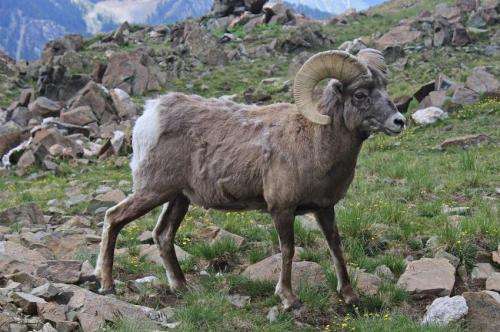August 13, 2014 report
Is trophy hunting affecting bighorn sheep evolution? Research says no

(Phys.org) —Trophy hunters prize the Alberta bighorn sheep. They aim to adorn their walls with the largest rams' horns they can obtain. In the past thirty years, average horn size has decreased, causing some scientists to believe trophy hunting is creating evolutionary pressure favoring rams with smaller horns. However, Lochran Traill and colleagues have created a model that simulates selective hunting and found it does not create a strong evolutionary response. The research appears in the Proceedings of the National Academy of Sciences.
Trophy hunters target animals with particular body traits, such as a large body or a distinctive color. If this trait is heritable, hunting can remove animals with these traits from the gene pool, resulting in negative selection. For example, if animals inherit body size, and hunters seek out larger animals, then smaller animals will tend to live longer and be more likely to reproduce than larger animals, causing the percentage of large animals in the population to decrease.
Earlier studies have shown that the average horn size of bighorn rams in trophy-hunted populations in Alberta and British Columbia has decreased over the past several decades. Trophy hunters prefer rams with the largest horns, particularly 4/5 degree curled horns. Some scientists have suggested that by hunting larger-horned rams but leaving smaller-horned rams alone, trophy hunters have encouraged evolutionary selection for small horns.
Traill and his team wanted to see if trophy hunting really was creating an evolutionary response. To do this, they designed a mathematical model to show whether inheritance has a strong effect on body mass in Alberta's Ram Mountain bighorn population. They studied body mass instead of horn size because there's a strong correlation between the two, and they didn't have enough field data on horn size to create a useful model.
The researchers examined what would happen to body mass within the population if they increased the mortality rates of adult and senescent males weighing more than 100 kilograms. They found that decreasing the number of large adult males who lived long enough to reproduce had only a weak effect on inheritance.
However, the model showed that there was a stronger effect on average body mass among older males and a shift in the sex ratio toward females. This suggests that while trophy hunting does not have a significant evolutionary effect, by removing larger males from the population, it causes average body mass - and therefore, average horn size - to decrease.
The team suggests that regulators take such models into account when developing rules to promote conservation.
More information: Demography, not inheritance, drives phenotypic change in hunted bighorn sheep, Lochran W. Traill, PNAS, DOI: 10.1073/pnas.1407508111
Abstract
Selective harvest, such as trophy hunting, can shift the distribution of a quantitative character such as body size. If the targeted character is heritable, then there will be an evolutionary response to selection, and where the trait is not, then any response will be plastic or demographic. Identifying the relative contributions of these different mechanisms is a major challenge in wildlife conservation. New mathematical approaches can provide insight not previously available. Here we develop a size- and age-based two-sex integral projection model based on individual-based data from a long-term study of hunted bighorn sheep (Ovis canadensis) at Ram Mountain, Canada. We simulate the effect of trophy hunting on body size and find that the inheritance of body mass is weak and that any perceived decline in body mass of the bighorn population is largely attributable to demographic change and environmental factors. To our knowledge, this work provides the first use of two-sex integral projection models to investigate the potential eco-evolutionary consequences of selective harvest.
Journal information: Proceedings of the National Academy of Sciences
© 2014 Phys.org





















